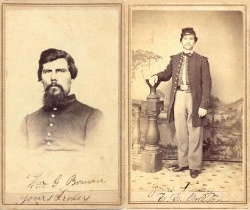Carte de visite



The carte de visite[1] (French: [kaʁt də vizit], visiting card), abbreviated CdV, was a type of small photograph which was patented in Paris by photographer André Adolphe Eugène Disdéri in 1854, although first used by Louis Dodero.[2][3] Each photograph was the size of a visiting card, and such photograph cards were commonly traded among friends and visitors in the 1860s. Albums for the collection and display of cards became a common fixture in Victorian parlors. The immense popularity of these card photographs led to the publication and collection of photographs of prominent persons.
History and format
The carte de visite was usually made of an albumen print, which was a thin paper photograph mounted on a thicker paper card. The size of a carte de visite is 54.0 mm (2.125 in) × 89 mm (3.5 in) mounted on a card sized 64 mm (2.5 in) × 100 mm (4 in). In 1854, Disdéri had also patented a method of taking eight separate negatives on a single plate, which reduced production costs. The carte de visite was slow to gain widespread use until 1859, when Disdéri published Emperor Napoleon III's photos in this format.[4] This made the format an overnight success. The new invention was so popular that its usage became known as "cardomania"[5] and spread quickly throughout Europe and then to America and the rest of the world.
By the early 1870s, cartes de visite were supplanted by "cabinet cards", which were also usually albumen prints, but larger, mounted on cardboard backs measuring 110 mm (4.5 in) by 170 mm (6.5 in). Cabinet cards remained popular into the early 20th century, when Kodak introduced the Brownie camera and home snapshot photography became a mass phenomenon.
American Civil War
The carte de visite photograph proved to be a very popular item during the American Civil War. Soldiers, friends and family members would have a means of inexpensively obtaining photographs and sending them to loved ones in small envelopes. Photos of Abraham Lincoln, Ulysses S. Grant, and other celebrities of the era became instant hits in the North. People were not only buying photographs of themselves, but also collecting photographs of celebrities.[6]
Gallery of cartes de visite
-
One of the first cartes de visite of Queen Victoria taken by photographer John Jabez Edwin Mayall
-
Tewodros II of Ethiopia in the 1860s.
-
Hector Berlioz, c.1864
-
Two photographs taken during the American Civil War. Each soldier shown here served with the 77th Illinois Volunteer Infantry.
-
A later cabinet card of a similar image of Sojourner Truth.
-
One of only two known photographs of Mary Seacole, taken by Maull & Company in London, c.1873.
-
Sim D. Kehoe, who brought Indian-club exercising to the United States from England.
-
Gordon, an enslaved man, reproduced by Mathew Brady.
-
Wilson Chinn, a branded slave from Louisiana--Also exhibiting instruments of torture used to punish slaves
-
A chair presented by Kinman to Abraham Lincoln. Kinman sold CdVs in the U.S. Capitol.
-
Fridtjof Nansen, Arctic explorer and scientist 1886.
-
An early cat macro by British portrait photographer Harry Pointer, c.1870s.
-
Camille Silvy's portrait of William Fane De Salis, London, 1861.
-
A. Kerpen. Beard 8 feet long, 11 years' growth
-
Rev. Christopher Newman Hall, British clergyman c.1860
See also
Notes
- ^ Also spelled carte-de-visite or erroneously referred to as carte de ville.
- ^ Welling
- ^ Leggat
- ^ Gernsheim p. 55
- ^ Newhall
- ^ Schweitzer, Marlis, and Joanne Zerdy. 2014. Performing Objects and Theatrical Things. Houndmills, Basingstoke; New York : Palgrave Macmillan. ISBN 9781137402448.
References
- Gernsheim, Helmut (1986). A Concise History of Photography. Courier Dover Publications. ISBN 978-0-486-25128-8. Retrieved 2010-10-16.
- Dr. Robert Leggat MA M.Ed Ph.D. FRPS FRSA
- Newhall, Beaumont. The history of photograph (1964)
- Silkenat, David (August 8, 2014). ""A Typical Negro": Gordon, Peter, Vincent Coyler, and the Story Behind Slavery's Most Famous Photograph" (PDF). American Nineteenth Century History. 15 (2): 169–186. doi:10.1080/14664658.2014.939807. hdl:20.500.11820/7a95a81e-909c-4e8f-ace6-82a4098c304a. S2CID 143820019.
- Welling, William. Photography in America (1978 & 1987)
External links
- Portraits of Scientists: Increase Lapham's Cartes-de-visite Collection Collected by pioneering Wisconsin antiquarian Increase A. Lapham between 1862–75, this album of carte-de-visite photographic portraits depicts many notable 19th-century scientists from America and Europe. Available on Wisconsin Historical Images, the Wisconsin Historical Society's online image database.
- University of Washington Libraries Digital Collections – 19th Century Actors Photographs Cartes-de-visite studio portraits of entertainers, actors, singers, comedians and theater managers who were involved with or performed on the American stage in the mid-to-late 19th century.
- William Emerson Strong Photograph Album -- Duke University Libraries Digital Collections 200 cartes de visite depicting officers in the Confederate Army and Navy, officials in the Confederate government, famous Confederate wives, and other notable figures of the Confederacy. Also included are 64 photographs attributed to Mathew Brady.
- Southern Cartes de Visite Collection, A.S. Williams III American Collection, Division of Special Collections, University of Alabama Libraries. Over 3300 digitized cartes de visite, the majority of them from southern studios.
- The Carte de Visite file at the New-York Historical Society
- Cartes de Visite of California photographers at Beinecke Library via flickr
















